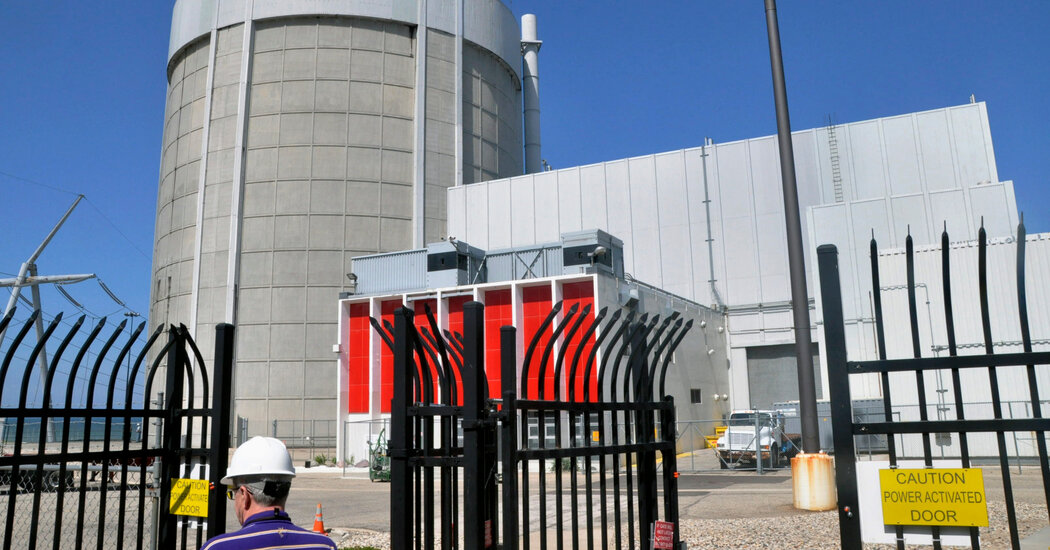Good. We keep shutting down nuclear plants and replacing them with gas. We need to stop shutting them down and go further, build more.
I’m not anti-nuclear, but from my understanding it’s not necessarily cost or resource-effective to build new plants, since other renewables have advanced so rapidly
If you just want the cheapest grid possible (regardless of emissions), renewables paired with gas is the cheapest. There are some exceptions to this, places like cloudy Seattle don’t make for good solar farms, which drives up the effective cost of solar significantly.
If you are shooting for a carbon-free grid, nuclear is notably cheaper than renewables paired with grid-scale storage. Notably, much of the nuclear cost is bureaucracy that keeps the plants in limbo for decades and are quite good at making this carbon-free power source unnaturally expensive. This bureaucracy can be brought to a reasonable level if there is political will.
Nuclear power plants also don’t have standardized parts afaik, driving up costs.
They do and they don’t. They don’t because they’re machines the size of buildings, but they do because most of their construction is just standard plumbing. Except the reactor itself, of course.
It’s pretty similar to shipbuilding. You can have a bunch of mass-produced components, even enormous components like shipping container engines, but the hull and superstructure still get made from scratch each time. And not just because of their size, but because each ship is going to be slightly custom, because it needs to fit a certain size envelope, or needs to deal with certain cargos or environmental conditions.
Similarly, a reactor needs to be built to fit the site, in terms of plain old footprint, but also for geology, water access (if using a river for cooling), and to be protected from storms, earthquakes, tsunamis, and other local disasters.
That’s simply an issue of not building enough of them.
Yes that’s my point
It probably isn’t right now because interest rates are high.
NuScale’s project a bit back got cancelled after they skyrocketed.
Nuclear power plants have a big up-front cost and then provide a return over a long period of time. So how much it costs to get that capital is really important.
Nuclear power plants have a big up-front cost and then provide a return over a long period of time
It appears the problem is a bit worse than that. Its a big up-front cost, then expensive operation, which means high prices to consumers for electricity generated by nuclear power compared to other power generation methods. Its the reason the plant was shut down in 2022.
“Entergy explained, “market conditions have changed substantially, and more economic alternatives are now available to provide reliable power to the region.”” source
So how eager are consumers to having their electricity bills go up to support nuclear power? Those in Georgia are feeling this on their electric bills with their additional reactors finally online:
“Bills went up $5 this month after Unit 3 entered commercial operation. That’s atop a $16-a-month increase to pay for higher fuel costs two months ago. There was also an increase in base rates early this year, with another scheduled next year.” source
So contrasting the Michigan plant, which is being restarted from cold, the Georgia plant which represents some new construction of reactors, Ohio electricity bills went up with a surcharge to subsidize two unprofitable nuclear plants.
“Bail out two nuclear plants: From 2021 until 2027, Ohio ratepayers will pay a new monthly surcharge on their electricity bills, from 85 cents for residential customers up to $2,400 for big industrial customers. The surcharge will produce about $170 million a year; $150 million of that will be used by the utility FirstEnergy Solutions to subsidize its two big nuclear power plants — Davis-Besse, outside of Toledo, and Perry, northeast of Cleveland — which it claims are losing money and will be closed in the next couple of years without bailouts” source
…Except Ohio is even worse than you think. The power company bribed the Republican Speaker of the House to get this legislation passed. After it was found out he’s now in prison for 20 years. source
…However, the corrupt legislation his bribery got signed into law still stand on the books today and Ohioans continue to literally pay for this corrupt action to subsidize these unprofitable nuclear plants.
As much as I like the zero-carbon electricity, nuclear is pretty darn expensive for what you get. You’ll open your wallet to pay for it, whether you want to or not.
After the boondoggle that Vogtle became I don’t think building new ones is a good idea. That’s a lot of money tied up and not making energy.
I do think refurbishing and reactivating old plants when possible makes sense. The timeline is a lot shorter, and it’s a lot cheaper than renewables. For example, the plant in the article can produce 2.5GW, and the same price would only get about 500MW of solar.
They’re expensive
Expensive to build much cheaper to run. Doesn’t take much time at all at the scale of the electrical grid for it to pay itself off.
If this were true, the levelized cost of nuclear energy would be much lower than it is:

Nuclear is expensive to build and expensive to run.
The heck why’s it’s more expensive now? I hadn’t looked in years wtf
In France, they are expensive to build and expensive to maintain… And you need to buy stuff from Russia to keep them running…
Why not (instead of gas and nuclear) building more renewables, which are cheeper? Wind and solar should be the priority, nuclear should be the alternative when wind and solar does not work.
I feel like people are looking at renewables the wrong way. a distributed grid makes sense. the same goes for grid-scale storage. when I looked at it last, it wasn’t too much to get around ~week’s storage for myself. Some solar panels on the roof, some storage tucked into a utlity closet, in every house, you have a distributed grid.
Supplement it with other renewables like wind, tidal and hydro; maybe pay people to store stuff, too, like they do with power going into the grid.
But yea, Nuclear is a reliable grid scale system.
when I looked at it last, it wasn’t too much to get around ~week’s storage for myself. Some solar panels on the roof, some storage tucked into a utlity closet, in every house, you have a distributed grid.
In the USA you’re looking at a price tag probably close to $150k+ for one family’s worth for total grid independence unless you’re willing to restrict which geography you live in or make pretty drastic lifestyle reductions. That week’s worth of storage batteries is going to set you back a lot.
You must be talking about more than just energy. Solar panels and a $10k battery don’t cost that much.
You must be talking about more than just energy. Solar panels and a $10k battery don’t cost that much.
I promise you, that isn’t an exaggeration in the USA. I recently had 17KW of solar panels installed and 10KWh of battery in my home.
10KWh fully charge will power a my home’s regular power consumption for less than a day, and that isn’t even charging any EVs. OP was speccing out one week’s worth of batteries and in many parts of the USA (and the world for that matter) you don’t get enough sun all day to even charge your batteries and power your household consumption. Hence my comment on reducing lifestyle consumption, or restricting your living to geographies that get more sun. I can talk full detailed numbers about my first hand experience if your interested.
Huh. Last I looked I was figuring around 15-17KW would be enough to fully power both my home and an EV. (You can actually look at your usage history from your electric provider to get past usage.)
I don’t know what “one week of batteries” means. If he means to power his house for an entire week with no solar production, that’s insane and probably is $150k. But you don’t need that much to be 98% independent.
Huh. Last I looked I was figuring around 15-17KW would be enough to fully power both my home and an EV.
And that 15-17KW of installed solar panels will cost you between $35k-$60k in cash (not a loan) without batteries (and before any state and federal incentives which have specific requirements). Most people don’t have that kind of money to part with for this application.
The devil is in the details. Assuming full sun it should be about right. However, even overcast days can cut your production down to 20% of normal, thats even forgetting storming days, and then there’s winter where you’ve got snow covering your panels for possibly days on end.
Further it gets into what your state and power provider has for “net metering”. Your panels produce well when its fairly cloudless and sunny. So that covers about 10 hours of the day (for part of the year, with the part being different depending on which hemisphere you’re in on the globe.) The best case scenario with production and the most generous net metering rules is that you generate an excess during the summer sunny days, and that carries you through pulling from the grid for your solar production shortfalls later in the cloudy fall and winter. However, most net metering schemes mean you only get a fraction of the power back later in the year that you give to the power company.
I don’t know what “one week of batteries” means. If he means to power his house for an entire week with no solar production,
I think thats what that poster meant.
that’s insane and probably is $150k. But you don’t need that much to be 98% independent.
I don’t disagree, but that was their definition, not mine.
Putting solar panels and a battery in every house is ok if everyone owns an actual house, has enough space for a battery and gets enough sunlight but it wouldn’t be possible in most cities where hundreds of people share a single roof that doesn’t have the space for all the panels required.
In some countries the houses wouldn’t be big enough to install batteries without taking up valuable living space, most terraced houses in the uk couldn’t fit a power bank inside without filling an entire room’s usable space.
You also have to deal with the fact that many grids aren’t built to deal with the power fluctuation that comes from each house providing power, my university has a solar and wind farm that has to be shut down sometimes because the nearby city can’t handle all the power it produces in the summer and that’s from a centralised source.
Powergrids need to be upgraded anyway, simply because of EVs and heat pumps. All the energy that was formerly distributed via gas stations and pipes now has to be pushed through the grid.
Apart from that, local storage is actually pretty great for handling fluctuations, since it’s essentially a smoothing capacitor.
Cities are a problem, but that’s what large scale production like wind is for. Obviously, large storage facilities are also needed, but hydro power, hydrogen and a few local batteries could easily supplement the grid.
All true, but if you slap panels on every rooftop you can- every square foot of rooftop panel is one less square foot of dedicated land needed for solar farms.
Most current homes could easily accommodate something (including a storage shack tucked against the house.)
The grid is an issue that’s going to have to get fixed anyway; we’re going away from mega-plants that produce power for entire states no matter anyhow.
Also we need to be distributed for climate resilience.
Well that is just silly instead of turning it off they should just mine some crypto.
The time for repositioning our renewables stance and grid was the 70s-00s. Now, it’s renewables at any cost, since a considerable portion of the country didn’t feel like climate change was a big deal until it was upon us.
Priority #1 is now reducing our carbon output by any means necessary, and we are still gonna get hit decently by climate change even if we meet our commitments (assuming 100% democratic wins/no undoing of policy through 2050)
Oh hey it’s my favorite big energy talking point, “it’s too late to decentralize the grid and rob us of our monopoly!”
We can do both, both is the fastest option. Both is the best way to deal with the inevitable effects of climate change.
I don’t care if there’s a nice shiny nuclear plant a state over if the lines have been shredded by massive storms.
This whole thing feels like a giant money pocketing scam. They shouldn’t have shut it down in the first place.
People are still afraid of nuclear power. It doesn’t matter that is a reliable green energy source that will last longer than we’ll ever need it to. It doesn’t matter that often the alternative is fossil fuels. Politicians don’t even want to touch this N word.
Radiation is scary, so plants are getting shut down all the time. Huge plants that were 60 year investments, that took 10 years to build, and are currently working great are being shut down right and left, guaranteeing that they’ll never make back the massive investment.
Shortsightedness is a huge (and expensive) problem as well as perhaps the most consistent aspect of human civilization.
In other words, this is an example of Hanlon’s Razor, it’s not a scam, it’s just pure, organic, all-natural stupidity.
I think nuclear energy is the way. I just don’t think human civilization is stable or responsible enough to house the waste for the 500k-1 million years for the half life to happen.
That said, it’s still the best way, even with waste being considered.
I hope our decendants loooove cleaning up messes.
Everybody cheering on nuclear seems to forget one big problem associated with it … nuclear waste. It’s just assumed that people living in remote regions will be fine and dandy having nuclear waste buried in their backyards, possibly poisoning their groundwater. Nevermind the transportation of said waste through more heavily populated areas which would lead to at least one catastrophic accident.
Imo the cost of that is far more important than what it costs to build in the first place.
Yes, nuclear waste is a problem. One we’ll need to solve in the next few decades. Those few decades will buy us time to get off of fossil fuels and onto more permanent renewable solutions though.
In* the short term, I’d much rather see more nuclear plants opening up, even with the long term drawbacks around waste storage, rather than more gas or coal plants. It’s the lesser of the two evils by a long shot.
That’s what they said in the 1970s. We still haven’t solved the problem fifty years later.
Sure, but I think there’s a ton of reasons for that, and most are not the fault of nuclear power itself.
Beyond replacing fossil fuels plants, nuclear plants can also help power atmospheric decarbonization (with their excess baseband power) as well as desalination plants if close enough to a coast.
There’s a lot of projects that depend on cheap and abundant energy that can further help undo some of the damage from a century of fossil fuels usage.
While the design lifespan of nuclear plants might be 30-40 years, newer ones are designed for 40-60 years of operation right off the bat.
So it’s a bit of a sticker shock at first but even getting just 40 years of benefits from each plant is huge.
A big part of the problem is we don’t look at these longtime operation periods and we externalize (or just ignore) the CO2 emissions as costs of running cheaper gas and coal power plants.
“In the short term”
The main problem is that all this theory doesn’t track with reality.
The mean construction time for nuclear reactors worldwide is 9.4 years and the US seemingly only finished one reactor (Watts Bar 2) in the last ten years which took 42.8 years to complete and ended up costing more than 12 billion. Watts Bar 1 was finished after 23 years and two others were abandoned, one by TVA after 47 years.
Correction: Unit 3 of the Westinghouse AP1000 reactor (Vogtle) was finished in 2023 in only 14 years costing 34 billion, while Unit 4 is still in construction.

The reason why China was able to build 39 reactors in a short amount of time is because they are using them to increase their nuclear arsenal. Projects like this tend to go faster if a dictatorship wants it to be done no matter the cost, public opinion and safety concerns.
It sounds like you’re suggesting that the reason the US takes longer to build nuclear plants is because of more rigorous safety requirements or something. I’m not convinced though, considering the US’s track record on the rest of its power infrastructure.
I think there are a ton of reasons why the US is so slow to build nuclear reactors, most of which have nothing to do with the technology itself.
Obviously the problem needs addressed though, and we know it’s a solvable problem - the chart you posted says as much.














